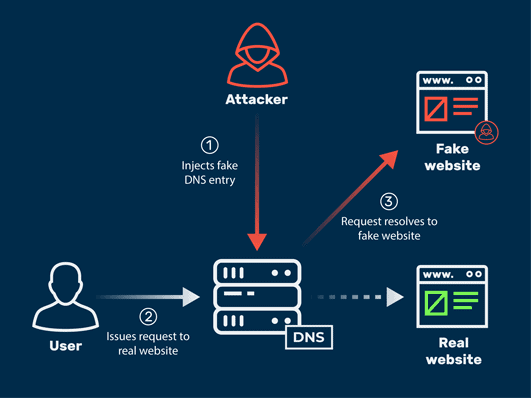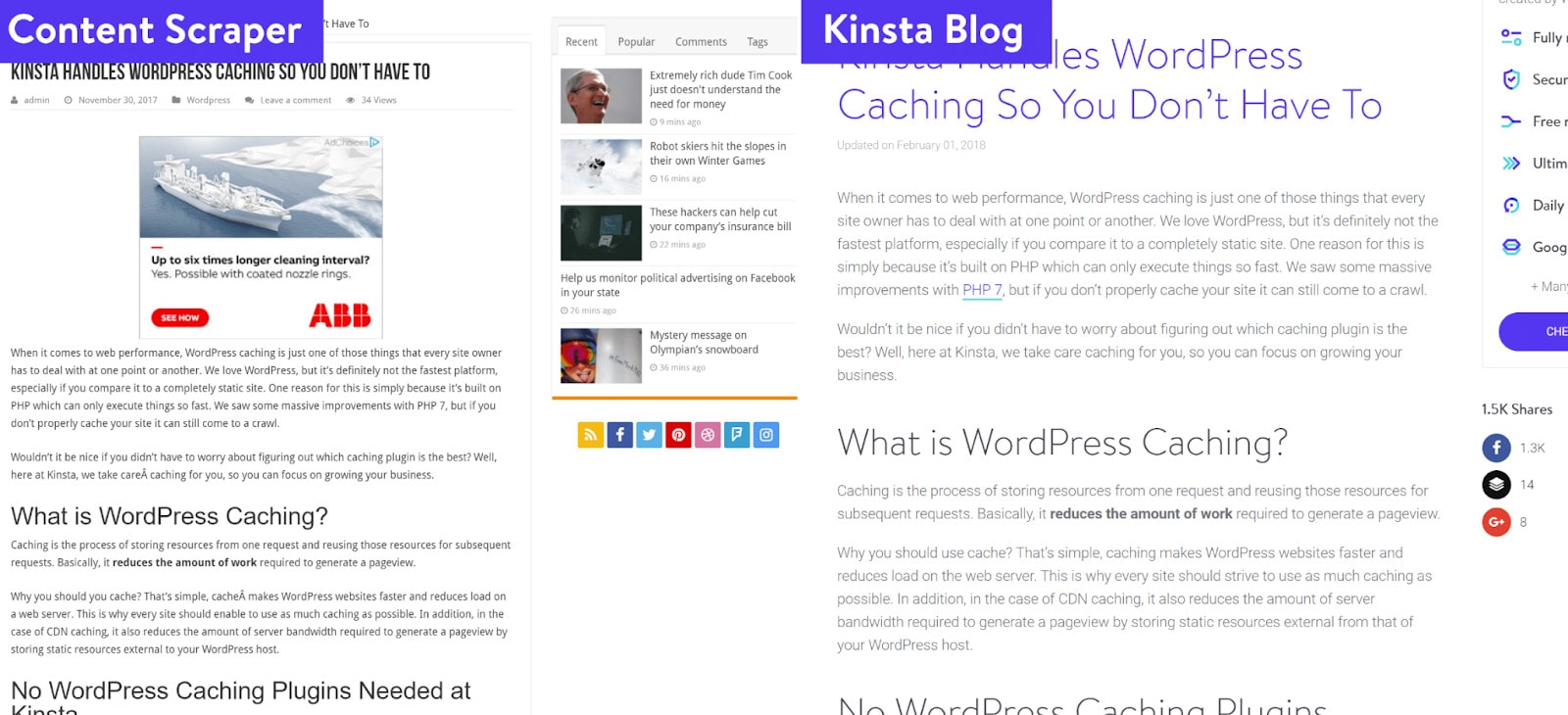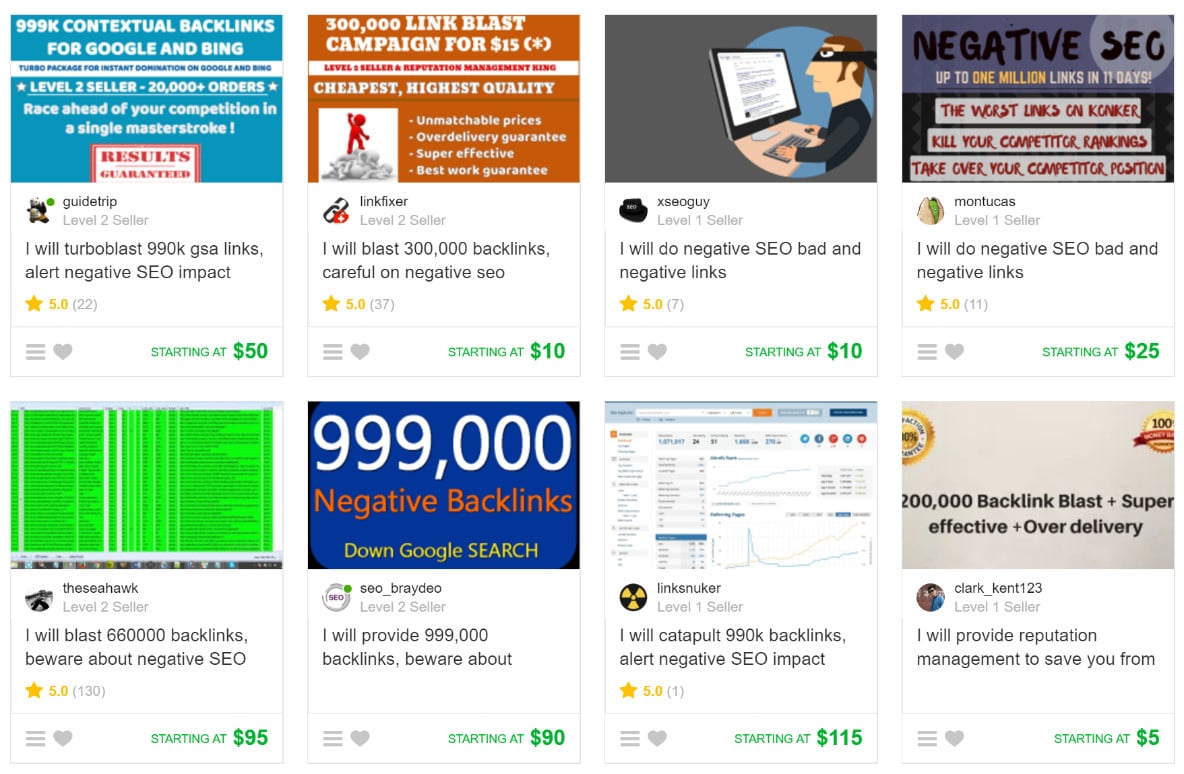Table of Contents
On average, 30,000 new websites are hacked every day. And hacking is just one way malicious actors use negative SEO to damage your website.
The goal of a negative search engine optimization (SEO) attack of is to harm your website’s rankings on search engines, and though Google has fought negative SEO for years with algorithm updates like Panda and Penguin, hackers and others will continue to find ways to damage and attack reputable websites.
Fortunately, there are techniques marketers can employ to fight negative SEO and get their website’s rankings back on track.
What is negative SEO?
Negative SEO is the practice of attacking a competitor’s website with the goal of hurting search rankings. It is a form of black hat SEO, which is the use of unethical techniques to trick search engine algorithms into altering search rankings.
An SEO attack on your site could include anything from harming your backlink profile by directing thousands of spammy backlinks to your website, to hacking your website and filling it with spammy links or even de-indexing your website entirely.
This is usually done because someone wants to get their competitor’s rankings on search engine results pages (SERPs) down so that their own content will rank higher on those SERPs. It’s black hat digital marketing, and it is even offered as a service online from some malicious actors.

Concerning negative SEO, John Mueller of Google has said, “Our systems work really hard to make sure that any kind of negative SEO or any kind of irrelevant backlinks — unnatural links — that as much as possible we’re able to ignore them completely.”
But Google isn’t perfect. So it pays to be prepared for negative SEO attacks. Here are some of the most common and how to deal with them.
Common negative SEO attacks and how to prevent them
Negative SEO attacks come in all shapes and sizes. For example, hackers might change the content on your website, or they might delete all your content.
Other forms of negative SEO trick search engines into lowering the ranking of your content. This includes creating link farms of spammy links that all point to a page on your website, or creating a large number of fake reviews to get your website to rank lower. Here are some of the most common.
Changing your content
This is an on-page negative SEO attack that’s difficult to execute but frustrating if it happens to you.
What it is
For this negative SEO attack to work, a hacker must gain access to your website and begin to change your content, sometimes subtly, sometimes not so subtly.
Usually, it depends on your website and what the goals of the hacker are. This happens to a lot of WordPress websites because they have a lot of vulnerabilities. The hacker edits your content in a number of ways.
First, they might insert spammy links into your content. Sometimes they can even hide these links — instead of just inserting them into a random phrase or adding new anchor text — so that you can’t see them, usually by inserting them in the HTML of the page.
These bad links can get you penalized by search engines, causing your page’s PageRank to drop. The hacker might also link to a legitimate website in order to boost the link profile of a page on that website, using the legitimate rankings of your site to make one of their pages rank higher, or, they might even use redirects to send your visitors to their page.

How to solve it
To solve it, you need to keep an eye on your content and regularly audit it to see if anything has changed. While this might be simple for a small business website that doesn’t regularly produce content, it can be difficult for a website that has a lot of new content created regularly.
Fortunately, there are tools you can use to audit your website to see if you suddenly have a lot more links than you should. An SEO audit is one tool you can use. You can also inspect specific URLs in Google Search Console (formerly known as Google Webmaster Tools) and Google Analytics to check key performance metrics over time.
Getting your site de-indexed
De-indexing a website is another technique that requires someone to hack your website. It’s difficult to execute, but a serious problem for website owners if it occurs.
What it is
Your robots.txt file is a simple-yet-crucial file on your website that tells search engines whether or not they should crawl certain web pages.
For one reason or another, you might want Google or Bing to not crawl/index certain pages on your website (like checkout pages or admin pages, for example), so you would use this file to direct them not to crawl those pages.
However, if a malicious actor hacks your website, they can change this file to tell search engines not to crawl your whole website (or certain pages) anymore, leading Google to take you off of Google Search.
How to solve it
You may be able to take care of this yourself, but if you’re not comfortable changing your robots.txt file, then you might want to ask your webmaster or whoever manages your website to handle this for you. In any case, it’s a simple fix to tell search engines to start indexing your website again, though it will take time for your rankings to return.
Hacking the site
The previous two types of negative SEO both require someone to hack your website, but hackers have many negative SEO tactics at their disposal and can do more than just insert low-quality links into your content or change your robots.txt file.
What it is
While there are many different forms that hacking can come in, not all of them involve inserting malware into your website. For example, hackers may engage in DNS spoofing, which is where traffic from your website is redirected to a malicious website.

Or, hackers might delete all your content. They could also replace all your content with pages and pages of bad links or spammy links. In some cases, they might just delete your website entirely. All of these things will hurt your search rankings and your ability to operate your business online.
How to solve it
The best way to solve a hack is to prevent it from happening in the first place. This means that you take website security seriously. For example, if you have a WordPress website, you might want to get a high-quality backup plugin to ensure your website always has a backup ready in case you get hacked.
You’ll also want to work with your host to resolve any issues. They can be a great help when you’ve been hacked and may actually have a backup of your website if you haven’t been backing up your website yourself.
Paying for security features/plugins is also a good idea, as is keeping your website software up to date. WordPress websites that haven’t been updated for a long time are targets of hackers because they usually have unpatched vulnerabilities.
Link farms
Another way that malicious actors can damage your website is by linking to it from link farms, creating an incredible number of links — thousands to hundreds-of-thousands of new links — to your website.
What it is
A link farm is a series of low-quality websites created by spammers that, when linked to your website, give the appearance that you are associated with low-quality web properties. To Google, it makes your site look as spammy as the sites in the farm that are linking to you.
You can see in the image where a link farm began linking to a website and what happened when they were able to disavow all the spammy links. At first, their organic traffic plummets, but once they disavow the spam links, it comes back.

Oftentimes, these links have nothing to do with your website. They’re just bad links from the referring domain. The goal of a link farm is to trick search engines into believing that your website is untrustworthy because it has so many bad links pointing to it, which can translate to a loss in rankings.
How to solve it
This is yet another reason why it’s important to regularly audit your website. You can use tools like Ahrefs to check your backlink profile and see if you’re suddenly getting a spike of links that takes place at the same time your traffic is suddenly falling off.
If that happens, your main method of fighting the attack is to disavow links like this. You can create a disavow file using tools like SEO SpyGlass that includes all the bad links you want to disavow. Disavowing just means you’re telling search engines that these are bad links and that you want nothing to do with them.
Investing in a disavow tool is just one more way you can protect your site, though most of these tools will give you a full suite of analytics for your backlinks. And they go beyond providing protection. They can help with link-building, too.
Scraping content and creating a duplicate website
Rather than hacking your website, malicious actors can simply steal it — or rather, steal the content on it.
What it is
In this negative SEO attack, someone copies all the content on your website and then makes another website with the exact same content. When search engines come across duplicate content on multiple pages, they either lower the rankings of both, or choose one piece of content to index and then deindex the duplicates.
Usually, Google and Bing are pretty good at spotting duplicate content, but not always, and besides hurting your search rankings, it’s blatant theft of your content.

How to solve it
To find out if this has happened in the first place, you’ll likely need anti-plagiarism tools like Copyscape to see if anyone has stolen your content and posted it online.
In most cases, stolen content doesn’t actually hurt your site’s rankings (other than the fact that you’ve been plagiarized). Google’s algorithm is excellent at spotting this type of content and determining which is spam and which is the original content.
That being said, you still likely don’t want someone stealing your content, so you can email the webmaster and ask them to remove the content from their website.
If that doesn’t work, you can report them to Google.
Creating fake negative reviews
While the other negative SEO techniques mentioned here usually aren’t personal, this one is, and a negative SEO campaign of this sort can cause serious damage to your business’ reputation.
What it is
When someone posts fake reviews for your business that are negative, they can have a serious effect on your business — both on reputation and your rankings in local search. Local search engine optimization relies heavily on reviews as a ranking factor, so lots of negative reviews can cause you to stop showing up as prominently for searches in your area.
Your business will also suffer directly because potential customers who are researching your business take reviews seriously. They may believe what they read, and they will make purchase decisions based on those reviews.
Of all the negative SEO techniques on this list, this is arguably the worst. It’s far more malicious. Most hackers target sites because they want their own site to rank higher — not because they want to totally damage their target’s reputation.
With fake reviews, someone is focused on harming your business. Because reviews can be left in a variety of places online — including on Google and social media — they have a number of places that they can post these fake reviews, which can make them hard to spot and deal with right away.
How to solve it
As a site owner, you are in charge of the reviews that you put on your website for your business, but there’s a lot less you can do about reviews that have been posted on social media or on Google/Bing.
While it’s possible to dispute reviews, the process isn’t foolproof. If the fake reviews are well done and appear real, Google may not remove them. You can see a list of what might violate Google’s policies here.
The main way you can fight fake negative reviews is by requesting real positive reviews from your customers. You then respond to all the fake reviews and clearly state that this review is fake. This shows potential customers your side of the story, even if Google won’t remove the reviews.
Creating fake backlink removal requests
Rather than spam you with bad backlinks, sometimes bad actors will try to get Google to remove your good links.
What is it
With this negative SEO tactic, a competitor or malicious actor makes a request to a website that links to you to remove some of your most valuable backlinks. They will email a webmaster at another site with an email address similar to yours and ask for the backlink to be removed. If the webmaster is tricked, there go your backlinks.
If they do this, you can see your PageRank drop, which in turn will cause your search rankings to drop.
How to solve it
To fight this, you need to keep a close eye on your backlinks. Pay attention to see if you lose any. If you do, you can try to email the webmaster that used to be linking to you, explain the situation, and then ask for your links to be reinstated.
The problem with this is that you might not be able to convince them to do so. Just like the previous tactic, this one is a little personal and requires someone to be actively trying to take your site down, likely to hurt your business or to help theirs.
Forceful crawling
This technique is similar to a DDoS attack in that large amounts of traffic are used to overwhelm your site.
What it is
A malicious actor crawls your website over and over, to the point that it slows your website down. Because page load speed is a ranking factor, if your website is unable to load quickly — or worse, if Googlebot is unable to crawl your site — then you may get de-indexed (or at the very least, lose some rankings on SERPs).
How to solve it
To solve this problem, you need to contact your host or webmaster so that you can pinpoint the source of the traffic. Once you’re able to do this, you can block the traffic coming in, or, if something else is slowing down your website, they should be able to help you figure out what’s causing it and put a stop to it.
Is negative SEO a legitimate threat?
Negative SEO is a legitimate threat. Although not all these attacks may be successful in the long run, they can still be successful for a limited time. And they’re offered more widely than you might think:

Google is getting very good at identifying negative SEO attacks, but it’s still difficult to spot and prove.
One Google employee says he’s never seen a case of negative SEO:
“Gary Illyes stated at PubCon Florida 2019 that out of hundreds of negative SEO reports he has examined, none of them were real.”
That said, if someone wants to create a host of fake reviews about your business, and they make them seem credible enough, that is a serious threat. With this form of negative SEO, crossing the wrong person (or just getting in the way of another business with unethical practices) can be all it takes for this threat to become very real and damaging.
This is just as true for getting your website hacked. Sure, you may not necessarily lose your rankings if you’re able to deal with it quickly, but losing your site (or losing traffic for a few days while you fix it) is a serious problem, regardless of whether or not the outcome is ultimately good.
In other cases — especially with link farms and content scraping — you likely have much less to worry about because Google has gotten very good at understanding which links should be ignored and which content is the original content (and which is stolen).
Overall, it’s something to watch out for. It’s a good argument for backing up your website, paying for a backlink monitoring tool, investing in security safeguards, and generally paying attention to the overall health of your website.
Get a complimentary SEO audit
Negative SEO isn’t something that should be a core focus of your SEO strategy, but it’s worth preparing for. Fortunately, with a little bit of work and the right monitoring tools, you can keep your website safe and deal with any negative SEO problems if they occur.
Want to see how you’re doing with SEO? Get an instant SEO audit below. Or, schedule a free consultation to see how intent SEO can boost search traffic revenue by 700%.
